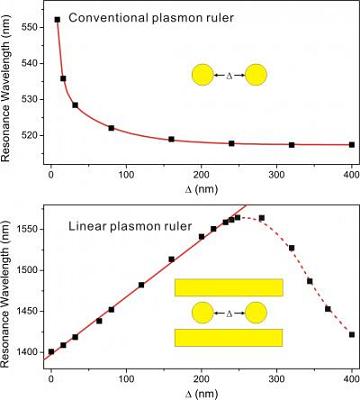Home > Press > Tiny rulers to measure nanoscale structures
 |
| In contrast to a conventional nanoparticle dimer plasmon ruler, this new one shows an approximately linear relationship between the resonance wavelength shifts and nanosphere dimer interparticle separation for a linear plasmon ruler. |
Abstract:
With the advent of nanometer-sized machines, there is considerable demand for stable, precise tools to measure absolute distances and distance changes. One way to do this is with a plasmon ruler. In physics jargon, a "plasmon" is the quasiparticle resulting from the quantization of plasma oscillation; it's essentially the collective oscillations of the free electron gas at a metallic surface, often at optical frequencies.
Tiny rulers to measure nanoscale structures
College Park, Maryland | Posted on September 1st, 2010A noble metallic dimer (a molecule that results from combining two entities of the same species) has been used as a plasmon ruler to make absolute distance and distance change measurements.
Physicists at China's Wuhan University discovered that nanospheres combined with a nanorod dimer could be used to solve the problem of measurement sensitivity. They provide details about their findings in the American Institute of Physics' Journal of Applied Physics.
Shao-Ding Liu and Mu-Tian Cheng used a nanostructure as a linear plasmon ruler. Nanospheres were used to modify surface plasmon coupling of a nanorod dimer. They found that the resonance wavelength shift increases approximately linearly with the increasing of a nanosphere's interparticle separations -- resulting in a structure that's useful as a plasmon ruler with homogenous measurement sensitivity.
"A nanoparticle dimer plasmon ruler possesses many advantages because its measurement sensitivity is homogeneous, it can operate in the near-infrared region, and the structure's size and nanorod aspect ratio can be modified freely to get the desired measurement range and sensitivity," notes Liu.
Applications for the linear plasmon ruler extend beyond studies of optical properties of metallic nanostructures to single-molecule microscopy, surface-enhanced Raman spectroscopy, waveguiding and biosensing.
More Information
The article, "Linear plasmon ruler with tunable measurement range and sensitivity" by Shao-Ding Liu and Mu-Tian Cheng will appear in the Journal of Applied Physics
jap.aip.org/resource/1/japiau/v108/i3/p034313_s1?isAuthorized=no
####
For more information, please click here
Contacts:
Corporate Headquarters
One Physics Ellipse
College Park, Maryland 20740-3843
301-209-3100
Copyright © American Institute of Physics
If you have a comment, please Contact us.Issuers of news releases, not 7th Wave, Inc. or Nanotechnology Now, are solely responsible for the accuracy of the content.
| Related News Press |
News and information
![]() Researchers develop molecular qubits that communicate at telecom frequencies October 3rd, 2025
Researchers develop molecular qubits that communicate at telecom frequencies October 3rd, 2025
![]() Next-generation quantum communication October 3rd, 2025
Next-generation quantum communication October 3rd, 2025
![]() "Nanoreactor" cage uses visible light for catalytic and ultra-selective cross-cycloadditions October 3rd, 2025
"Nanoreactor" cage uses visible light for catalytic and ultra-selective cross-cycloadditions October 3rd, 2025
Physics
![]() Quantum computers simulate fundamental physics: shedding light on the building blocks of nature June 6th, 2025
Quantum computers simulate fundamental physics: shedding light on the building blocks of nature June 6th, 2025
![]() A 1960s idea inspires NBI researchers to study hitherto inaccessible quantum states June 6th, 2025
A 1960s idea inspires NBI researchers to study hitherto inaccessible quantum states June 6th, 2025
![]() Magnetism in new exotic material opens the way for robust quantum computers June 4th, 2025
Magnetism in new exotic material opens the way for robust quantum computers June 4th, 2025
Possible Futures
![]() Spinel-type sulfide semiconductors to operate the next-generation LEDs and solar cells For solar-cell absorbers and green-LED source October 3rd, 2025
Spinel-type sulfide semiconductors to operate the next-generation LEDs and solar cells For solar-cell absorbers and green-LED source October 3rd, 2025
Academic/Education
![]() Rice University launches Rice Synthetic Biology Institute to improve lives January 12th, 2024
Rice University launches Rice Synthetic Biology Institute to improve lives January 12th, 2024
![]() Multi-institution, $4.6 million NSF grant to fund nanotechnology training September 9th, 2022
Multi-institution, $4.6 million NSF grant to fund nanotechnology training September 9th, 2022
Discoveries
![]() Researchers develop molecular qubits that communicate at telecom frequencies October 3rd, 2025
Researchers develop molecular qubits that communicate at telecom frequencies October 3rd, 2025
![]() Next-generation quantum communication October 3rd, 2025
Next-generation quantum communication October 3rd, 2025
![]() "Nanoreactor" cage uses visible light for catalytic and ultra-selective cross-cycloadditions October 3rd, 2025
"Nanoreactor" cage uses visible light for catalytic and ultra-selective cross-cycloadditions October 3rd, 2025
Announcements
![]() Rice membrane extracts lithium from brines with greater speed, less waste October 3rd, 2025
Rice membrane extracts lithium from brines with greater speed, less waste October 3rd, 2025
![]() Researchers develop molecular qubits that communicate at telecom frequencies October 3rd, 2025
Researchers develop molecular qubits that communicate at telecom frequencies October 3rd, 2025
![]() Next-generation quantum communication October 3rd, 2025
Next-generation quantum communication October 3rd, 2025
![]() "Nanoreactor" cage uses visible light for catalytic and ultra-selective cross-cycloadditions October 3rd, 2025
"Nanoreactor" cage uses visible light for catalytic and ultra-selective cross-cycloadditions October 3rd, 2025
|
|
||
|
|
||
| The latest news from around the world, FREE | ||
|
|
||
|
|
||
| Premium Products | ||
|
|
||
|
Only the news you want to read!
Learn More |
||
|
|
||
|
Full-service, expert consulting
Learn More |
||
|
|
||








